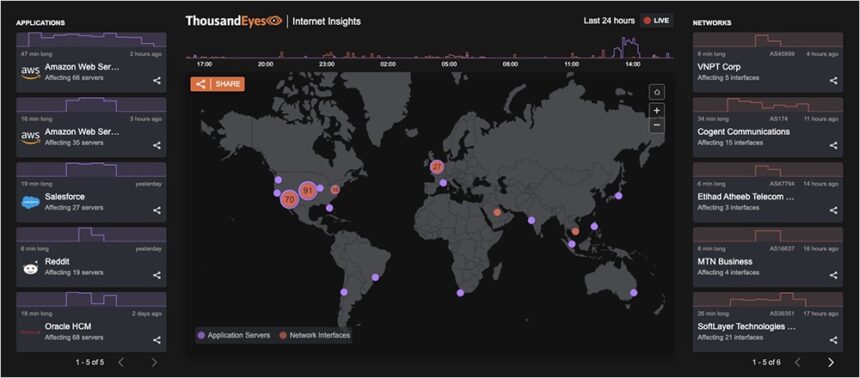The Internet’s Backbone Shakes as Amazon’s Cloud Falters
Amazon Web Services (AWS) — the engine powering much of the modern web — experiences one of its largest disruptions in years, taking down Snapchat, Fortnite, Canva, Coinbase, Delta Air Lines, and even Amazon’s own services.
The outage began early Monday, with reports flooding in from around the world. According to Down Detector, the problem starts around 9 a.m. CET, initially centered in AWS’s US-EAST-1 region — the hub in Northern Virginia that anchors a massive portion of global cloud infrastructure.
For hours, millions lose access to platforms they rely on daily. Amazon, in its statement, confirms “significant error rates” affecting DynamoDB, its core data service, while engineers rush to restore operations. The company later announces that “most services show early signs of recovery.”
What’s Happening & Why This Matters
When the Cloud Fails, the Internet Trembles
AWS underpins about 30% of the global cloud infrastructure market, serving over four million customers, from startups to financial institutions. When AWS stumbles, the effects ripple far beyond entertainment and e-commerce — they hit airports, communication networks, and even public systems.
This time, the fault lies in DynamoDB’s data request errors, which spread through the U.S. East region. According to ThousandEyes, a website monitoring firm, Virginia’s heavy concentration of data centers worsens the impact. Flights slow down at LaGuardia Airport in New York, HMRC in the U.K. reports service interruptions, and European telecom providers SFR and Free struggle to maintain connectivity.
Coinbase reassures users via X that “all funds are safe.” Still, downtime across multiple crypto and banking platforms sparks user frustration and questions about the resilience of centralized systems.
A Familiar Pattern Emerges
The event draws comparisons to the CrowdStrike outage earlier this year, which grounded flights and shut down hospitals worldwide. Both cases show how overreliance on single providers — whether cybersecurity or cloud infrastructure — exposes global systems to cascading failures.
Cori Crider, executive director of the Future of Technology Institute, voices concern:
“Europe’s dependency on monopoly cloud companies like Amazon is a security vulnerability and an economic threat we can’t ignore.”
Crider urges European governments to invest in local, diversified cloud services. Her point resonates — AWS’s dominance means that when its servers fail, the world slows down.
Engineers Scramble, Recovery in Progress
AWS engineers act quickly, applying “initial mitigations” and tracking early signs of recovery across affected systems. Still, requests continue failing for hours as services clear “backlogs of queued work.”
Charlotte Reck, a cloud analyst at CNN, reports that Amazon confirms recovery across global services, though latency remains for some users. The statement from AWS reads:
“We have applied initial mitigations and are observing early signs of recovery. We continue to work towards full resolution and provide updates as more information becomes available.”
For many, it’s a reminder that the internet’s cloud architecture — touted for stability — still depends on a handful of players.
Experts Call for Diversification
Industry professionals call for structural reform. Charlotte Wilson, head of enterprise at Check Point Software Technologies, advises:
“Today’s outage is another reminder that the digital world doesn’t stop at borders — a local fault can ripple worldwide in minutes.”
She recommends data diversification, maintaining offline backups, and establishing redundant cloud networks. While corporations embrace AI, real-time analytics, and streaming services, few account for their dependence on one provider’s uptime.
TF Summary: What’s Next
The AWS outage reinforces a simple truth — centralization equals vulnerability. Amazon’s speed in identifying and mitigating the failure shows technical maturity, yet the scale of disruption raises new urgency for multi-cloud strategies and digital sovereignty.
MY FORECAST: Expect regulators, particularly in Europe and North America, to revisit cloud infrastructure oversight and possibly demand redundancy requirements for critical sectors. As reliance on cloud computing deepens, resilience — not innovation — defines the next battleground.
— Text-to-Speech (TTS) provided by gspeech


